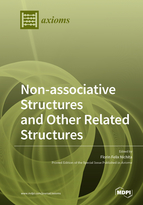Non-associative Structures and Other Related Structures
A special issue of Axioms (ISSN 2075-1680). This special issue belongs to the section "Algebra and Number Theory".
Deadline for manuscript submissions: closed (20 December 2019) | Viewed by 24233
Special Issue Editor
Interests: (co)algebras; bialgebras; Yang–Baxter equations; Lie (co)algebras; quantum groups; Hopf algebras; duality theories
Special Issues, Collections and Topics in MDPI journals
Special Issue Information
Dear Colleagues,
Non-associative algebras are currently a fashionable research direction. There are two important classes of non-associative structures: Lie structures and Jordan structures. Various Jordan structures play an important role in quantum group theory and in fundamental physical theories.
In recent years, several attempts to unify non-associative structures have led to interesting results. The UJLA structures are not the only structures which realize such a unification.
Associative algebras and Lie algebras can be unified at the level of Yang–Baxter structures. Several papers published in the open access journal Axioms deal with the Yang–Baxter equation.
The Yang–Baxter equation can be interpreted in terms of logical circuits and, in logic, it represents a kind of compatibility condition when working with many logical sentences in the same time. This equation is also related to the theory of universal quantum gates and to quantum computers. It has many applications in quantum groups and knot theory.
Contributions related to non-associative structures, various aspects of the Yang–Baxter Equation, and their applications are invited.
Dr. Florin Felix Nichita
Guest Editor
Manuscript Submission Information
Manuscripts should be submitted online at www.mdpi.com by registering and logging in to this website. Once you are registered, click here to go to the submission form. Manuscripts can be submitted until the deadline. All submissions that pass pre-check are peer-reviewed. Accepted papers will be published continuously in the journal (as soon as accepted) and will be listed together on the special issue website. Research articles, review articles as well as short communications are invited. For planned papers, a title and short abstract (about 100 words) can be sent to the Editorial Office for announcement on this website.
Submitted manuscripts should not have been published previously, nor be under consideration for publication elsewhere (except conference proceedings papers). All manuscripts are thoroughly refereed through a single-blind peer-review process. A guide for authors and other relevant information for submission of manuscripts is available on the Instructions for Authors page. Axioms is an international peer-reviewed open access monthly journal published by MDPI.
Please visit the Instructions for Authors page before submitting a manuscript. The Article Processing Charge (APC) for publication in this open access journal is 2400 CHF (Swiss Francs). Submitted papers should be well formatted and use good English. Authors may use MDPI's English editing service prior to publication or during author revisions.
Keywords
- Yang–Baxter equation
- Non-associative algebras
- Lie structures
- Jordan structures
- Associative algebras
- Unification theories
- Braces
- Noncommutative algebras
- Applications in physics
- Duality
- Knot invariants
Benefits of Publishing in a Special Issue
- Ease of navigation: Grouping papers by topic helps scholars navigate broad scope journals more efficiently.
- Greater discoverability: Special Issues support the reach and impact of scientific research. Articles in Special Issues are more discoverable and cited more frequently.
- Expansion of research network: Special Issues facilitate connections among authors, fostering scientific collaborations.
- External promotion: Articles in Special Issues are often promoted through the journal's social media, increasing their visibility.
- e-Book format: Special Issues with more than 10 articles can be published as dedicated e-books, ensuring wide and rapid dissemination.
Further information on MDPI's Special Issue polices can be found here.





